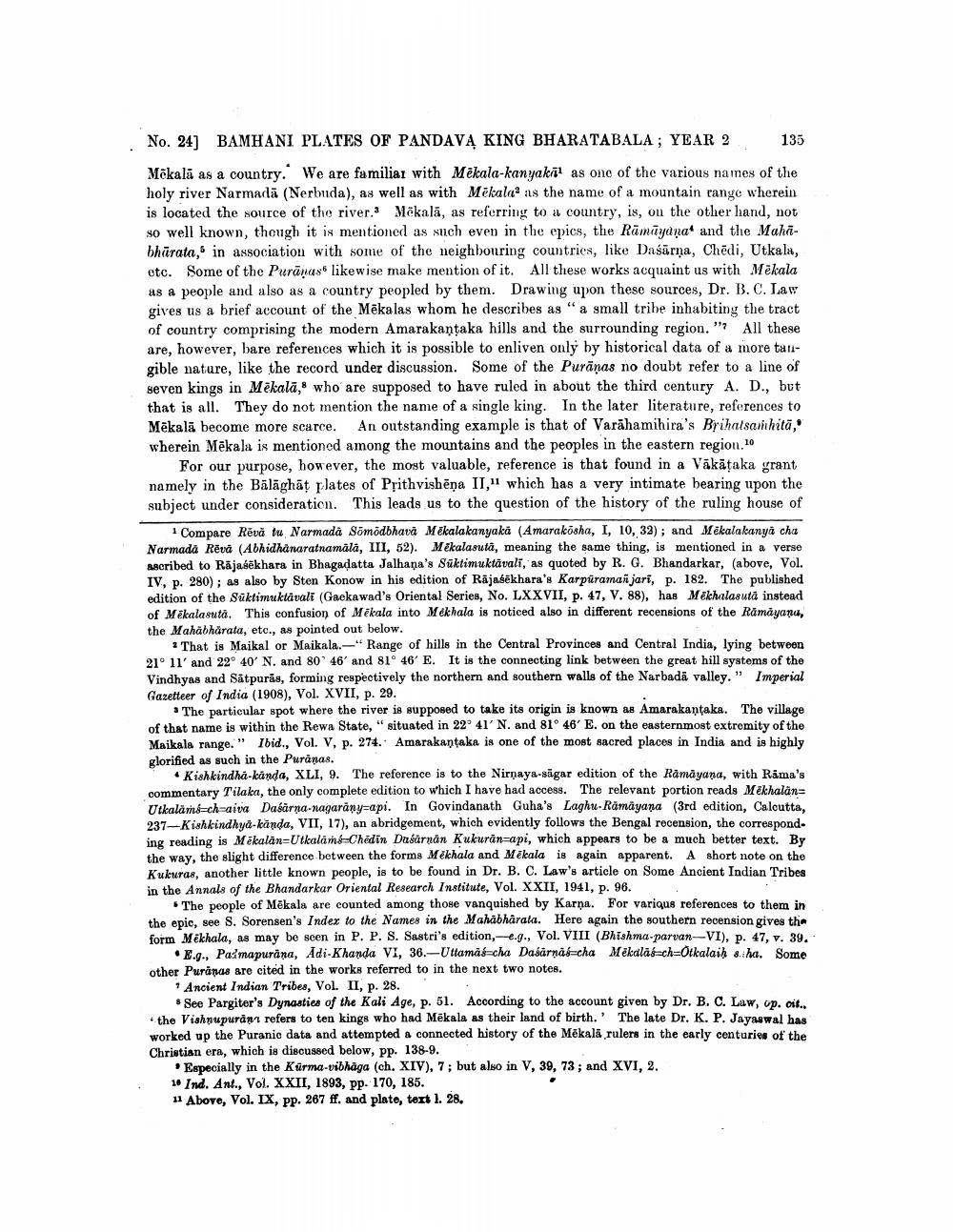________________
No. 24] BAMHANI PLATES OF PANDAVA KING BHARATABALA ; YEAR 2
135
Mēkalā as a country. We are familiar with Mēkala-kanyakril as one of the various names of the holy river Narmadā (Nerbuda), as well as with Mēkala as the name of a mountain range wherein is located the source of the river. Mēkalā, as referring to a country, is, ou the other hand, not so well known, though it is mentioned as such even in the epics, the Ramayana and the Mahibhürata, in association with some of the neighbouring countries, like Dnsurna, Chodi, Utkala, etc. Some of the Purāmas likewise make mention of it. All these works acquaint us with Mēkala as a people and also as a country peopled by them. Drawing upon these sources, Dr. B. C. Law gives us a brief account of the Mēkalas whom he describes as "a small tribe inhabiting the tract of country comprising the modern Amarakantaka hills and the surrounding region." All these are, however, bare references which it is possible to enliven only by historical data of a more tangible nature, like the record under discussion. Some of the Purānas no doubt refer to a line of seven kings in Mēkalā," who are supposed to have ruled in about the third century A. D., but that is all. They do not mention the name of a single king. In the later literature, references to Mēkala become more scarce. An outstanding example is that of Varahamihira's Brihalsain hitā, wherein Mēkala is mentioned among the mountains and the peoples in the eastern region. 10
For our purpose, however, the most valuable, reference is that found in a Vākāțaka yrant namely in the Bālāghāt plates of Prithvishēņa II," which has a very intimate bearing upon the subject under consideration. This leads us to the question of the history of the ruling house of
Compare Rēvă tu Narmada Sõmódbhavā Mēkalakanyaka (Amarakosha, I, 10, 32); and Mēkalakanya cha Narmadā Rēvá (Abhidhanaratnamála, III, 52). Mēkalasuta, meaning the same thing, is mentioned in a verse ascribed to Rājasēkhara in Bhagadatta Jalhana's Sūktimuktāvali, as quoted by R. G. Bhandarkar, (above, Vol. IV, p. 280); as also by Sten Konow in his edition of Rajasekhara's Karpuraman jari, p. 182. The published edition of the Süktimuktavali (Gaekawad's Oriental Series, No. LXXVII, p. 47, V. 88), has Makhalasuta instead of Mēkalasuta. This confusion of Mēkala into Mekhala is noticed also in different recensions of the Rāmāyanu, the Mahabharata, etc., as pointed out below.
? That is Maikal or Maikala.--"Range of hills in the Central Provinces and Central India, lying between 21° 11' and 22° 40' N. and 80° 46' and 81° 46' E. It is the connecting link between the great hill systems of the Vindhyas and Satpurās, forming respectively the northern and southern walls of the Narbadā valley." Imperial Gazetteer of India (1908), Vol. XVII, p. 29.
* The particular spot where the river is supposed to take its origin is known as Amarakantaka. The village of that name is within the Rewa State," situated in 22° 41' N. and 81° 46' E. on the easternmost extremity of the Maikals range." Ibid., Vol. V, p. 274. Amarakantaka is one of the most sacred places in India and is highly glorified as such in the Puranas.
• Kishkindha-kanda, XLI, 9. The reference is to the Nirnaya-sägar edition of the Ramayana, with Rama's commentary Tilaka, the only complete edition to which I have had access. The relevant portion reads Mēkhalan= Utkalamb ch-aiva Daśärna-nagarany-api. In Govindanath Guha's Laghu-Ramayana (3rd edition, Calcutta, 237-Kishkindhya-kanda, VII, 17), an abridgement, which evidently follows the Bengal recension, the correspond ing reading is Mēkalan=Utkalams-Chedin Dušarnan Kukuran-api, which appears to be a much better text. By the way, the slight difference between the forms Mēkhala and Mēkala is again apparent. A short note on the Kukuras, another little known people, is to be found in Dr. B. C. Law's article on Some Ancient Indian Tribes in the Annals of the Bhandarkar Oriental Research Institute, Vol. XXII, 1941, p. 96.
The people of Mēkala are counted among those vanquished by Karna. For varique references to them in the epic, see S. Sorensen's Index to the Names in the Mahabharata. Here again the southern recension gives the form Mēkhala, as may be seen in P. P. S. Sastri's edition,--.g., Vol. VIII (Bhishma-parvan-VI), p. 47, v. 39.
•E... Padmapurana, Adi Khanda VI, 36.-Uttamās cha Dasarnascha Mēkalas-ch=Olkalaih 8 ha. Some other Puranas are cited in the works referred to in the next two notes. Ancient Indian Tribes, Vol. II, p. 28.
. • See Pargiter's Dynasties of the Kali Age, p. 51. According to the account given by Dr. B. C. Law, op. oit.. the Vishnupuramt refers to ten kings who had Mēkala as their land of birth.' The late Dr. K. P. Jayaswal has worked up the Puranic data and attempted a connected history of the Mēkalā rulers in the early centuries of the Christian era, which is discussed below, pp. 138-9.
Especially in the Kürma-vibhaga (ch. XIV), 7; but also in V, 39, 73; and XVI, 2. 1. Ind. Ant., Vol. XXII, 1893, pp. 170, 185. 11 Above, Vol. IX, pp. 267 ff. and plate, tort l. 28.




